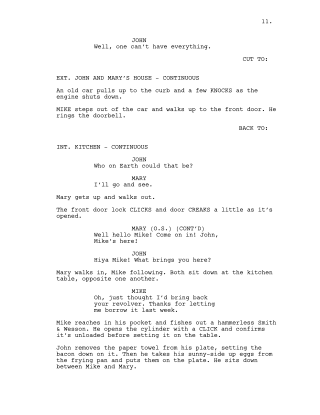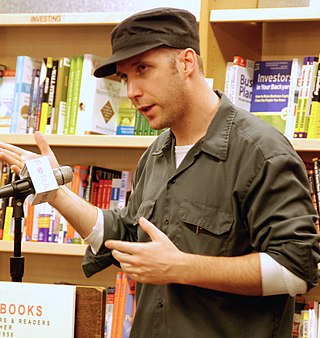
A film crew is a group of people, hired by a production company, for the purpose of producing a film or motion picture. The crew is distinguished from the cast, as the cast are understood to be the actors who appear in front of the camera or provide voices for characters in the film. The crew is also separate from the producers, as the producers are the ones who own a portion of either the film studio or the film's intellectual property rights. A film crew is divided into different departments, each of which specializes in a specific aspect of the production. Film crew positions have evolved over the years, spurred by technological change, but many traditional jobs date from the early 20th century and are common across jurisdictions and filmmaking cultures.
In the performing arts, a scenario is a synoptical collage of an event or series of actions and events. In the commedia dell'arte, it was an outline of entrances, exits, and action describing the plot of a play, and was literally pinned to the back of the scenery. It is also known as canovaccio or "that which is pinned to the canvas" of which the scenery was constructed.

A screenplay writer is a writer who practices the craft of screenwriting, writing screenplays on which mass media, such as films, television programs and video games, are based.

A storyboard is a graphic organizer that consists of illustrations or images displayed in sequence for the purpose of pre-visualizing a motion picture, animation, motion graphic or interactive media sequence. The storyboarding process, in the form it is known today, was developed at Walt Disney Productions during the early 1930s, after several years of similar processes being in use at Walt Disney and other animation studios.
A screenplay, or script, is a written work by screenwriters for a film, television show, or video game. A screenplay written for television is also known as a teleplay. Screenplays can be original works or adaptations from existing pieces of writing. A screenplay is a form of narration in which the movements, actions, expressions and dialogue of the characters are described in a certain format. Visual or cinematographic cues may be given, as well as scene descriptions and scene changes.
A teleplay is a screenplay or script used in the production of a scripted television program or series. In general usage, the term is most commonly seen in reference to a standalone production, such as a television film, a television play, or an episode of an anthology series. In internal industry usage, however, all television scripts are teleplays, although a "teleplay by" credit may be classified into a "written by" credit depending on the circumstances of its creation.
Pre-production is the process of planning some of the elements involved in a film, television show, play, or other performance, as distinct from production and post-production. Pre-production ends when the planning ends and the content starts being produced.

A script breakdown is an intermediate step in the production of a play, film, comic book, or any other work that is originally planned using a script.
Filmmaking or film production is the process by which a motion picture is produced. Filmmaking involves a number of complex and discrete stages, starting with an initial story, idea, or commission. It then continues through screenwriting, casting, pre-production, shooting, sound recording, post-production, and screening the finished product before an audience that may result in a film release and an exhibition. Filmmaking occurs in a variety of economic, social, and political contexts around the world. It uses a variety of technologies and cinematic techniques.
A step outline is a detailed telling of a story with the intention of turning the story into a screenplay for a motion picture.

Screenwriting or scriptwriting is the art and craft of writing scripts for mass media such as feature films, television productions or video games. It is often a freelance profession.
A script supervisor is a member of a film crew who oversees the continuity of the motion picture including wardrobe, props, set dressing, hair, makeup and the actions of the actors during a scene. The notes recorded by the script supervisor during the shooting of a scene are used to help the editor cut the scene. They are also responsible for keeping track of the film production unit's daily progress. The script supervisor credit is typically in the closing credits of a motion picture. Script supervisors are a department head and play a crucial role in the shooting of a film. It is the script supervisor's job to monitor the camera shots, seeking to maintain coherence between the scenes.
A storyboard artist creates storyboards for advertising agencies and film productions.
Script coverage is a filmmaking term for the analysis and grading of screenplays, often within the "script development" department of a production company. While coverage may remain entirely oral, it usually takes the form of a written report, guided by a rubric that varies from company to company. Criteria include, but are not limited to:

Michael Arndt is an American screenwriter. He is best known as the writer of the films Little Miss Sunshine (2006), Toy Story 3 (2010), and Star Wars: The Force Awakens (2015).
Screenwriting software are word processors specialized to the task of writing screenplays.
A scriptment is a written work by a movie or television screenwriter that combines elements of a script and treatment, especially the dialogue elements, which are formatted the same as in a screenplay. It is a more elaborate document than a standard draft treatment. Some films have been shot using only a scriptment.
Movie Outline is a word processing program developed by Nuvotech Limited. It is used to step outline a cinematic story and format a screenplay. It was created by Dan Bronzite, an English screenwriter. It was released in 2004 as an outliner with more features added in later releases.

Sophocles was a Windows-based screenwriting software application used for writing feature film and television screenplays. The program first became available on the Internet in 1999. Its distinguishing features included a two window screen setup, showing the script and screenplay outline simultaneously.
This glossary of motion picture terms is a list of definitions of terms and concepts related to motion pictures, filmmaking, cinematography, and the film industry in general.







